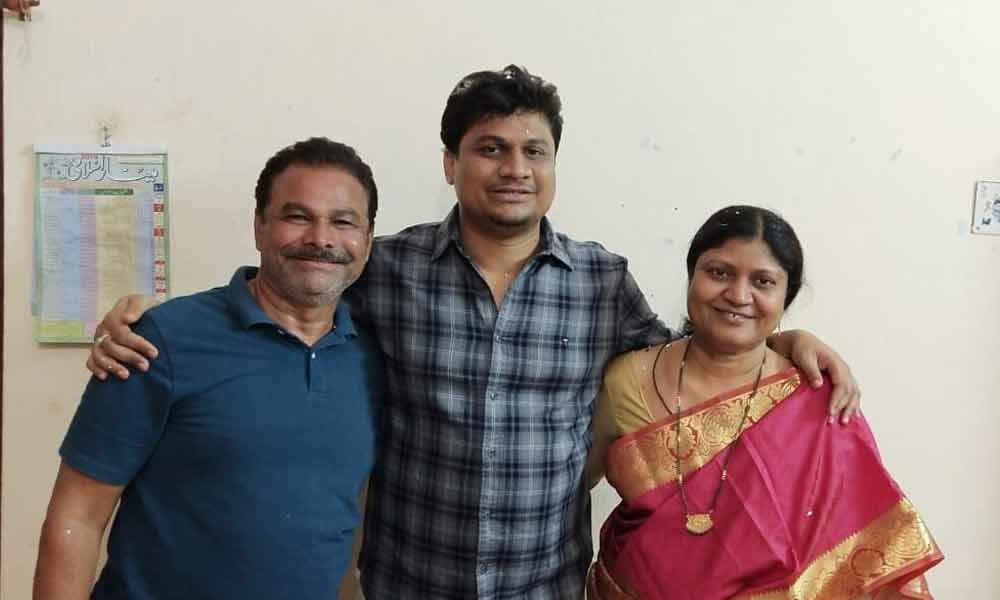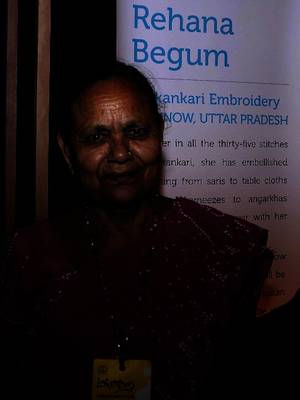“I learned from my father Shree Hasan Mirza, who received a national award in 1969 for his craftsmanship,” says fifty eight year old Rehana Begum.
Hailing from a long line of chikankari exponents, Rehana Begum began her work with this form of embroidery at the age of thirteen.
Chikankari dates back two centuries. The word chikan is thought to be derived from a Persian word; one theory is that the form travelled to India when its artisans migrated from Persia in search of better patronage. I t is believed that these artisans found a patroness in Mughal Empress Noor Jahan, wife of Emperor Jehangir, and that she did a lot to promote and popularize this craft form.
Rehana Begum works from her home in Thakur Ganj, Napier Road, Lucknow. “We are Lucknowi, born and bred.” Her whole family is involved with making Chikankari embroidery. They work as a group in one room which has become the embroidery room of the house.
“When I was younger we embroidered kurtas, topis, angarkhas jaise nawab log pehn te te (just like the nawabs used to wear). Now we do saris, suits (salwar kameez), ladies tops, whatever the new styles of dressing are in fashion now we embroider.”
Chikankari, she says, was traditionally done only on pure, un-dyed white shazaada cotton or Dhaka ki mulmul, both sourced from Dhaka, Bangladesh. The katcha daagha, the thread used for the embroidery, was also white and procured from Calcutta or Dhaka. Rehana Begum defines Chinkankari in her terms as ‘white on white’ embroidery.
“The first thing I made all by myself was a table cover. It took me one and half years to complete.”
And how long does it take to embroider a sari? “About two years. We usually work six to eight hours a day. My eyes aren’t what they used to be, so now I only do about two hours of embroidery work a day. I spend the rest of the time supervising the work of my apprentices and teaching them the various stitches.”
Rehana Begum takes her inspiration for her embroidery motifs from Mughal architecture. The delicate marble jaali (trellis) pattern of Mughal-style windows and parapet walls is transposed onto the fabric as a fine gossamer trellis of thread work. She also replicates the inlay patterns from Mughal monuments on the fabric she embroiders.
Chikankari has six basic stitches and over thirty-five other traditional stitches used in various combinations based on what the pattern to be embroidered requires. The names of some of these stitches are phanda, chana patti, ghaas patti, bijli, jaali, tepchi, bakhiya, hool, zanzeera, rahet, banaarsi, kharau, keel kangan, bubul and hath kadi. Depending on the type of garment and the pattern to be embroidered the entire process happens in a series of stages over a period of months or even years. Also, the embroidery itself is divided among the artisans, with pairs or groups of three or more specializing in one particular stitch. When one group completes their particular stitch for a garment, it is passed on to the next group to add their specialty stitch. One group may also have mastery of two or more stitches.
The pattern to be embroidered is stamped onto the fabric by hand with a wooden pattern block that has been coated with neel (indigo). The fabric now has the outlines of the designs that will be embroidered into the delicate ‘shadow’ embroidery motifs that are the defining feature of Chikankari.
“I would like to open a shop of my own someday,” Rehana Begum says hopefully. “What we kaarigars (artisans) get at the end of the day, after the shops and agents have taken their percentage—it isn’t much. I’d like to be able to meet directly with people who want to buy our work. Maybe we should have something like a kaarigar market…”
She and her family do travel extensively to participate in national textile fairs and handicraft exhibitions, but though sales are good, the travel costs add up. The price of raw materials has increased too, with good quality cotton and thread getting steadily more expensive.
“I love what I do,” she says emphatically. “There’s no way I could have done this for so long if I didn’t. I get a lot of satisfaction when I finish a piece. I have a large sample swatch that I take with me to exhibitions or when I get called to travel abroad. It took me three years to embroider. When I show it to people they are always amazed by the work. I feel very happy when I see their reactions.”
Rehana Begum has been invited to show case her work in Hamburg (Germany), Ireland, Cuba, Dubai and Muscat (Oman).
In 1976, she was given a State Award from the Uttar Pradesh government, and her work has been on display in the Crafts Museum of Uttar Pradesh. In 2003 she received the Shilp Guru award for her contribution to Chikankari.
“I am excited about coming to Chennai in October. I haven’t been to that city in a long time. I see it as an opportunity to show the international artisans who will be attending this event that Hindustan has great craft talent. They will be able to see what a wealth of kaarigars we have. Jo bhi kaarigar waha maujood honge, hum sab milkar hamare desh ka naam roshan karenge. (All of the artisans who gather for this event, together we will make the name of our country shine).”
source: http://www.thehindu.com / The Hindu / Home> Indian Crafts> Crafts / by Rashmi M.D. / Chennai – October 10th, 2012










